busy
Sunday, October 12th, 2008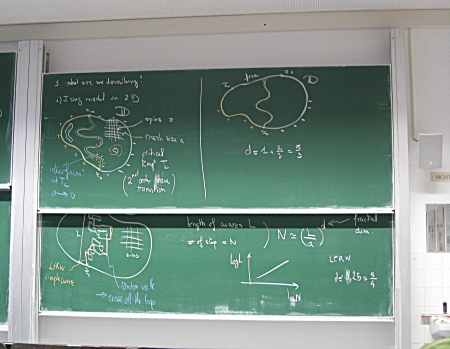 artsy illustrations by Denis Bernard
artsy illustrations by Denis Bernard
We are currently busily zooming between, Japan, Berlin and Munich and in between I was trying to learn about boundary CFT.
randformblog on math, physics, art, and design |
 artsy illustrations by Denis Bernard
artsy illustrations by Denis Bernard
We are currently busily zooming between, Japan, Berlin and Munich and in between I was trying to learn about boundary CFT.

As already mentioned in the last post I am going to supervise the exercises of a quantum computing class. Quantum computation was already a couple of times mentioned on this blog (like here), but I never really explained it to our art and design readership.
This blogpost belongs to series of posts related to the issue of focus and context.
So how can one describe quantum computation within a few words? Michael Nielsen, who actually wrote a whole book with Isaac Chuang about quantum computing (and who seems to be fed up with it?), tried this already on his blog.
I would like to try the same however differently with maybe fewer words (?), by using an analogy. So hopefully my post is kind of supplementary to Michael Nielsens.
In a natural language the information is conveyed in a way which may be ambiguous, i.e. words may have many meanings and thus the interpretation of their meaning depends on a given context. One can see this e.g. in the ambiguity of translations.
An example:
Look at the in the above art work mentioned german word “wegetreten”. “wegetreten” could be interpreted as “wege treten” (weg=path, treten=step), so the translation would be “pathmaking” or it could be interpeted as the word “wegetreten” read as: “weg getreten” (weg=away, getreten=stepped) meaning “pushed away” or -as a second meaning “stepped aside” or it could be read as “weh getreten” (weh=pain) (with a slight orthographic deformation) and thus would mean “to have injured”. So if a CEO gives a speech and would say the sentence: “Mit unserem neuen Ansatz werden wir Wege treten, die uns in neue Dimensionen führen” (with our new ansatz we will produce plathways which will lead us into new dimenions) then due to the addition: “which will lead us into new dimensions” it is rather clear what he/she meant – it’s quite a standard CEO sentence.
However without the addition the meaning of that sentence would depend on the exact pronounciation (i.e. the “e” in “weg” would be spoken slightly shorter in “weg-getreten” than in wege-treten, which sounds the same as weh-getreten). If you cant perceive the precise pronouncation like because this CEO is always mumbling then “mit unserem neuen Ansatz werden wir Wege treten” could also mean: “with our new ansatz we will be pushed away”, I.e. it would have rather the opposite meaning of “with our new ansatz we will be producing new pathways”. One could probably recover the correct meaning of the sentence if one would know the rest of the speech, or if one would know to whom this sentence was adressed, i.e. if one would know the given context.
(There is a bit about Homonyms in this randform post. In this post also metaphors were mentioned. However including metaphors would make things even more complicated so lets leave them out for a moment).
So conveying the information “wegetreten” (like in a SMS and allowing for a slight orthographic freedom) means to convey at least the above four meanings of “wegetreten” – all at the same time. And if you send this information like in a SMS then the interpretation will depend on what the receiver of the information knows about you and his/hers interpretation will depend on that given context (a bit on the different approaches towards context sensitvity was mentioned in this randform post).
Other forms of context may be that the interpretation may depend on the emotional and/or psychological state of the receiver a.s.o. (The interpretation of a code (which is here in our above example a word), or in other words the choice of an associated meaning was already discussed a bit e.g. in this randform post. The difficulty of choosing codes were indicated here and here or here)
A “state” in quantum mechanics is something like a “word”, i.e. you send some information, but its actual information, that is its meaning – may be blurred. I.e. instead of having only one definite meaning or none at all (“word switched on or off”) the meaning could be ambiguous.
Lets simplify a bit and recall briefly what’s in a normal computer: A computer program can be seen as a high level “translation” of a table of “yes'” and “no’s” or “on and offs”. These tables of “yes” and “no’s” provide rules of how to modify “switches” (electronic components) which are connected so that they form “circuits”. These circuits in the turn modify data (which is also given in terms of “yes'” and no’s”). Sometimes the programm is “hardwired” (like burned into a chip) and thus forms a kind of unit with the electric circuits. In particular a “cascade of switches” can be seen as a programm.
So the information in a normal computer is encoded in terms of bits, i.e. giant tables of the two possibilities “yes” and/or “no”. One calls this often “binary” (logic) which comes from the greek word “bi=two”. In a quantum computer this is different, i.e. the information is “blurred”. This means that the information is usually not a definite “yes” or “no”. So it is a bit like in our above analogy.
One can actually simulate a quantum computer with a normal computer by using the mathematical description of quantum mechanics, however in most cases you would need giant computers for the simulation of a relative small quantum computer.
But lets return to the analogy:
Choosing a “word”, i.e. choosing a bunch of certain possible meanings is in analogy to a “quantum mechanical preparation of a state”. A quantum mechanical “measurement” is in analogy to an “interpretation”. Since the context is influencing the probability of an interpretation one could see “context” in analogy to a set of “quantum gates” or “quantum circuits” which are the “circuits” of a quantum computer.
Quantum circuits are in in analogy to the usual electronic circuits you have e.g. on your ardunio board, i.e. they manipulate data. However the physical realization of quantum circuits is different from usual electronical circuits since quantum circuits make direct use of quantum mechanics and the usual electronic circuit boards make use of quantum mechanics only in a rather indirect way. In particular the encoding and processing of information in quantum circuits is different (this is what I tried a bit to explain above) from the one for electronic circuits, which use -as already pointed out- binary (or other like e.g. ternary) logics.
Due to this difference this in particular implies that if you remodel binary logical gates like in genetic design (like in synthetic biology e.g. with biobricks or within DNA computing) then the outcome will more resemble an ordinary computer (however with biological substituents and may be partly fuzzy logic) than it will resemble a quantum computer. Although there may be quantum logical effects also in biological composites, as e.g. indicated in this randform post.
Using the above analogies you could play being a quantum computer with your friends. I.e. by sending out ambiguous sentences and by waiting for their interpretation (which you somewhat see by their response). You could form chains (“circuits”), where you transmit the information, similar to the game “Stille Post” – just that you may also reformulate.
However it should be pointed out that the above is only a more or less weak analogy. There are major differences between such a game and real quantum computing. One important difference is that once a quantum mechanical measurement took place the original quantum state is usually considered to be distroyed. In our analogy this would mean that once an interpretation has been made no other interpretation would be possible any more.
In particular if you (I call you Alice) send your information to someone called Bob and someone intercepts your communication and would interpret it then Bob would know that someone intercepted your communication since he couldn’t interpret your message anymore properly. This feature is at the heart of “quantum encryption“. Another basic feature is the socalled “entanglement” which would mean that – looking again at the analogy – two words are entangled. I.e. if someone interpretes one word then the meaning of the other word would be instantanously determined. This feature is at the heart of the socalled quantum teleportation protocoll.
On the other hand if one assumes that there may be quantum mechanical effects taking place in our brain then this would shed a different light on such a game. Unfortunately it is also clear that a quantitative evaluation of such a game would be extremely difficult, if not impossible, since it is related to personal interpretation. Maybe one can find more thoughts on that issue in this new book by A. Connes, M. Heller, S. Majid, R. Penrose, J. Polkinghorne and A. Taylor (which I haven’t looked at yet) (book blog).
One should make some comments on the possible important applications of quantum computers.
One application is that they could be used for evaluating theoretical models of mesoscopic quantum systems, which could be incredible helpful for the design of new materials (like for solar cells or nano medication) (see also this research seminar)(if we generously assume that patent laws are abolished, because otherwise I see quite some conflicts ahead which will be due to patented genes, patented software algorithms, patented processes of nanofabrication etc. )
Another fact is that there are certain computer algorithms with which certain problems can be solved much faster than with ordinary computers. In particular the security systems of banks and military are relying on such algorithms. In other words having such a powerful new computer would mean that one could break more or less into all current security codes in the world.
And that is why i consider it to be highly problematic if private companies are pursuing research in such a security relevant branch. And it would be especially brisant if these companies would be known for pursuing rather restrictive politics with regard to openness, intellectual property rights etc.
But that is also why quantum computing is a rather hot topic and thus a lot of students want to learn it and even do the exercises..:).
In my mathematical work I mainly touched upon a part of quantum computation which is called topological quantum computation. The main (rather loose) connections are dating back to my Ph.D. thesis (from 1996…) which I may put online, if I should ever find the time to do so. I may eventually also write up some stuff, which is sofar still somewhat buried in my mind.
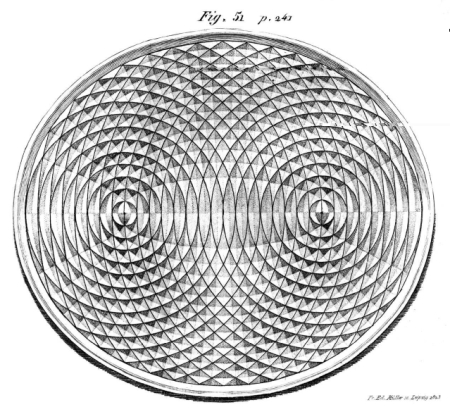
The above scientific visualization (which displays the wave pattern of a little droplet dropped into mercury in one focus of the ellipse) can be found in a book by Wilhelm Weber and his brothers Ernst Heinrich Weber. It can be found in principle on p.582 in the html version or on p. 619 of the pdf version at a google books scan of the book: “Wellenlehre auf Experimente gegründet, oder, über die Wellen tropfbarer Flüssigkeiten mit Anwendungen auf die Schall und Lichtwellen” (The theory of waves based on experiments or about waves of drippable liquids with applications to sound and lightwaves). The book is from 1825. Unfortunately the google scan has not such a nice quality as e.g. a scan of galileos works mentioned in this randform post. In particular in the google scan one can’t read that the drawing was made by:

Is Fr. Ed. Mueller the secret pioneer of Op Art?
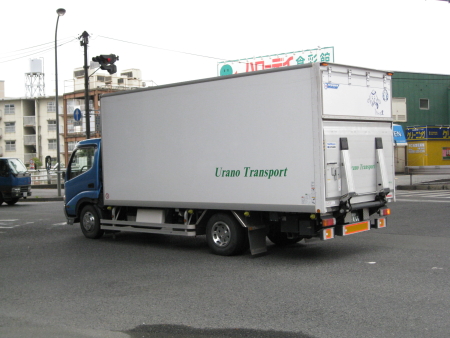
I hereby post the answer to new comments by a reader called Ken concerning the previous discussion about the future use of nuclear energy (please see the preceding posts). Again I think that they give a fairly good overview about the current stage of the discussion.
Ken’s comments are again in light grey blockquotes.
You again misunderstand the concept of a resource peak. It is when the supply and demand curves deviate. Not when the resource runs out.
Hi Ken, thanks for the comments, here my answers:
In the blogpost I wrote: “with the nowadays conventional commercial use of nuclear energy the Uran sources will be finished in about 60 years.”
In my answer to your last comment I wrote:
“..you can put it also like this: it seems to be cheaper to built breeders than to employ more costly exploitation methods.”
So maybe I expressed myself unclear. With “nowadays use sources will be finished” I meant that uranium wont be available anymore for the nowadays use and prices. So this is in particular the case when supply and demand curves deviate. Means: instead of the nowadays use of nuclear energy one will make more and more use of other technology in order to compensate for the higher and higher prices for uranium exploitation. It is clear that there will be in principle still Uranium on earth in 80 years, but it will be harder and harder to exploit it, so one will increasingly built breeders.
U233 is the desired product of the Thorium cycle, not a waste product.
First even if you would use U233 in a closed cycle, I believe that there will always be rests in the reprocessed spent fuel. Secondly to my knowledge up to now there exist only research plants, which are capable of burning U233.
According to world nuclear
India thinks about burning U233 in a three stage process:
* Pressurised Heavy Water Reactors (PHWRs, elsewhere known as CANDUs) fuelled by natural uranium, plus light water reactors, produce plutonium.
* Fast Breeder Reactors (FBRs) use this plutonium-based fuel to breed U-233 from thorium. The blanket around the core will have uranium as well as thorium, so that further plutonium (ideally high-fissile Pu) is produced as well as the U-233. Then
* Advanced Heavy Water Reactors burn the U-233 and this plutonium with thorium, getting about 75% of their power from the thorium.
So according to this plan, next to the uranium-233, plutonium will be produced in a fast breeder. Given that Russia has already problems to burn all of its plutonium from old weapons (half life of Plutonium 239: 24,110 years), it is clear that this creates a plutonium market which wants to feed itself. And just think about the high proliferation risk of plutonium.
I can give the British Jounal of Cancer Research article that shows the inverse correlation between proximity of children to nuclear power plants and the incidence of cancer.
Yes thanks I would like to have a look at it.
When I spoke of cancer causing chemical agents I was not referring to those leaching from nuclear power plants, I was speaking for those from the hundreds of vastly less regulated industries that are in the same areas nuclear power plants are located as well as distrubuted through out the country.
These industries could be a reason for cancer, so it would be important to include the local industries in a study which investigates the causes for a higher cancer risk near a nuclear power plant.
You vastly underestimate the difficulty in containing the witches brew of heavy metals that come form coal burning power plants and claim falsely that it is easier to contain mercury from coal plants, which accounts for up to 40% of all environmental mercury and will stay with us for a very long time. Mercury is only one toxin emmited and rarely contained from coal plants. The waste from nuclear plants is contained. Very little ever makes its way into the environment.
I didnt claim that it is possible to fully contain mercury from coal plants, I just said that there exist mercury filters, which one could think about employing in existing coal plants as a fast measure against blasting all this mercury into the air.
As a matter of fact it seems that also burning forests contribute to the mercury in the air, in this article in a (rather conservative) german newspaper it is claimed that this contribution is far higher than by coal plants.
But again: I am not in favour for coal. In particular if we speak about conventional green house gas emmitting power plants then there is a variety of alternative power plant types, which seem to be less environmentally harmful than coal plants.
And again: in principle one should try to do everything possible to employ renewable energies sources and not greenhouse gas emitting sources.
Although I should feel honored by the attention, your analysis is more polymical than analytical and so I really am just frustrated by your response.
Would I spent all this time answering carefully to your comment if I wanted to be polemical? I surely take your comments serious, last not least one can only test back ones own hypothesis’ in a discussion.
Second comment by Ken:
Here is the problem,
“In short: if mankind is unable to deal with this rapid expansion it probably doesnt matter how we blow up our planet.”
Why do you think this is even possible with commercial nuclear reactors.
The question was how to deal with a rapid population and industrial growth/expansion. The problem is that with or without commercial nuclear reactors at some point the problems regarding the distribution of ressources, let it be food, place, energy etc. will accumulate. And it is very suggestive that there will be wars about scarce ressources. Thats what I basically meant with “blowing up the planet”. Nuclear reactors do not help in solving these substantial problems. On the contrary due to a high proliferation risk, due to a hardly controllable waste problem etc. they just postpone and make the problems worse and rather irreversible. Like if a soil is radioactively polluted then it is lost for a long long time.
Also your argument for “renewables” is not founded on physics. No matter how efficient you think that wind mills will become, they will not provide the power needed. You can debate this, but you will lose. Solar is the same. The cost of these technologies are also (meaning in addition) prohibitive.
I consider solar energy to be a renewable energy. Regarding the costs one has to take into account a lot of things.
Look at the example of photovoltaic solar cells (it is the example I know about best, thats why I prefer to use this example over windmills, hydropower, thermosolar energy, geothermal energy or other renewable energies, but there are similar arguments for these energies). So just as an example: Solar cells used in spain produce electricity which costs roughly as much as electricity produced in conventional power plants. In Germany this looks different, because there is just not so much sun. So one has to look carefully at the local circumstances. The price e.g. for photovoltaic solar cells depends currently highly on the price of high pure silicon which is currently rather high due to the demand for high pure silicon in the semiconductor industry. But first this price is declining and secondly there are now slowly emerging companies who specialize on producing silicon for solar cells (which needs not always be that highly pure). Moreover there is a lot of research going on with other materials for photovoltaic solar cells. So there exists prognosis’ that the price for electricity produced with photovoltaic solar cells will be even in Germany down to conventional energy prices within a few decades. I wrote a bit about solar cells here in this and this post.
We have here also the question of where the money for research went and goes. I still think there should be some money go into research in nuclear energies, however the bulk money should be put into renewable energies and energy saving technologies. There is now a project of a whole city to be built in Abu Dhabi, which will be “fueled” only by renewable energies.
So my argument for “renewables” is definitely founded on physics and even on economical considerations.
Spent fuel rods are DANGEROUS. Stand within a score of meters of one after it has been pulled from a reactor and it will kill you with an absolute certainty. So will standing inside a blast furnace. I do not suggest that you do either. So what? Nearly every home in the Western world, by law, has trace amounts of Americium. It is classic reactor waste. It is probably in your hall way, keeping you safe. Millions of smoke detectors are thrown away in land fills every year. This is the same stuff that the famous radioactive boyscout used to drive his back yard nuclear reactor. I do not advocate being caviler about this, but you definately have expressed a favoritism towards coal over against a technology that is vastly less polluting, not just in terms of heavy metals but CO2 and acid rain.
I again like to point out that I am not in favour of coal.
It is safe and efficient and you would prefer that we put up windmills that are inefficient.
What means safe? With any technology you may have problems and sometimes life-endagering problems. The question is just, where do we expect more problems and where is a higher likelyhood of problems. windmills are definitely less dangerous than nuclear power plants, especially on a long term basis. About the efficiency of renewable energies I wrote already above.
Reactor and fuel designs are evolving very rapidly as well. You are using statistics to swat at gnats when there are vultures circling. Compared to the heterocyclic hydrocarbons, heavy metals and other toxins produced by a variety of industrial activities, the trace amounts of radiation that might leak into the environment from nuclear power plants is not harmful.
If a nuclear power plant works as planned then you are right, the traces of radiation should be OK with the given scientific knowledge. But firstly this scientific knowledge may change, like for example the recommended values for an absorbed dose are largely based on scientific studies done in relation to the events in Hiroshima and Nagasaki, so under quite a bit different conditions than the one one has in the case of a longterm dose of a nuclear power plant. Secondly I think the problems due to nuclear waste, accidents (think also of transport) and proliferation are much more important than the radiation of a normal working power plant.
We live in a cocktail of chemicals, how do you so easily single out radiation as the source in any epidemiological study, it seems like it would be very hard.
Where did someone single out radiation as a source?
The childhood cancer study gave no reason or cause for the higher incidence of Leukemia they ust stated that there is a higher risk.
The researchers said (but that was not part of the study) that given the
allowed radiation from a power plant and given the current scientific knowledge of a harmful absorbed dose one shouldnt get a higher Leukemia risk by living near a power plant. But the study says that there is a higher risk. So in short: There s a higher risk, but nobody knows why.
A good indication wether radiation is the source for that higher Leukemia risk would be to look wether the occurences of Leukemia are spatially homogenously distributed, but maybe they do not have not enough samples for that. I dont know.
People get worried about harmful isotopes within fuel rods but drink organo-mercurial compounds without a second thought. They fret about radiation causing the leukemia around Sullifield, even after it is demonstrated that the real culprit was munitions manufacturing during WW II.
I didnt look into that case.
Is it better to figure out a way to clean up the chemicals or get rid of the reprocessing plant. I’ll bet if you did the later it wouldn’t affect out comes that much. but would cost resources that may be better spent attempting the former, I’m just guessing.
You won’t get rid of the reprocessing plants. Reprocessing plants are used in order to reuse parts of the spent fuel, you could e.g. use reprocessed uranium in a fast breeder or plutonium in MOX fuel.
If you shuttered the nuclear plants you would replace them with coal fired ones. Would that be a step in the right direction? You believe that you are doing the right thing in your opposition to nuclear power, are you?
The share of nuclear energy is currently about 6% of the total worldwide energy consumption. Alone better energy saving would reduce the energy comsuption by far more than 6%, so you wouldnt need to replace them with coal plants. On average. What do I mean by on average? This means that also if you have to built a coal plant, because you couldnt provide renewable energies fast enough to substitute the need of electric currency at a particular location (a location where you switched off a nuclear power plant) and because you dont have the money for a cleaner conventional green house as emmitting power plant (one could see this as an international task to help developping countries in avoiding to employ coal plants) then there should be a coal plant saved somewhere else, where energy saving and renewable energies were already efficiently employed.
Yes at the moment I think I am doing the right thing in opposing commercial nuclear power, but I am also very concerned about the global warming (see eg here, so in particular i see keeping up nuclear research as a fall back option in case global warming would lead to a series of survival-of-mankind-threatening effects. But currently this is not the case. So as I already wrote at the moment I think nuclear energy is rather counter productive in solving the problems and I am not suggesting good old coal as the preferred substitute.
The US National Institute of Standards and Technology has released a beta version of some chapters of a Digital Library of Special Functions. The final atlas is expected 2009 and shall be available in print as well. The figures showing graphs are in 3D as well and here good old VRML comes back again. If I had been asked I kwould have opted for either a more recent file formar or a simpler one.

The above image displays a visualization of the socalled blancmange curve at various iteration steps and with a slightly randomized sawtooth function. The blancmange curve -not to confuse with the blancmange pudding– is -like e.g. also the devils staircase a socalled pathological function, i.e. a function which displays a counterintuitive behaviour. In order to obtain the blancmangecurve one sums up little sawteet h which get smaller and smaller. However also if the sawteeth are getting in the end infinitely small this particular curve will never be smooth.
mathematical subleties after the more
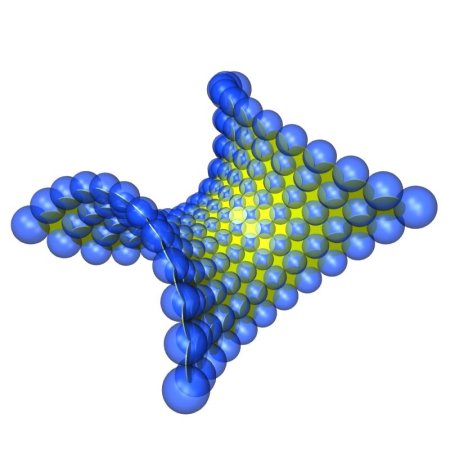
s-isothermic enneper surface by Tim Hoffmann
According to the blog tesselion (via boing boing) which is a blog about the project tesselion (Project Collaboration: Marc Fornes (www.theverymany.net), Adrienne Yancone (www.diecreative.com)) :
Recently the development of planar quadrilateral meshes have become a strong interest in the architectural community due to their potential ease for constructing complex surfaces. A race has begun to develop a system of flat panelization of free form surfaces which would enable large scale, efficient and economic, construction from flat sheet material.
I didnt know that there was an architectural race going on!
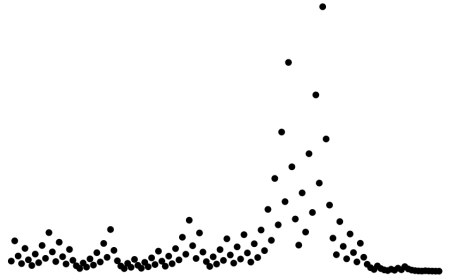
Who says all the unsolved math problems are difficult to phrase?
The Collatz conjecture can be phrased as a simple question: Start with a positive number. If the number is even take its half otherwise take 3 times the number plus 1. Now do this over and over again. The (yet unanswered) question is: will this process allways reach the number 1?
(from there the sequence of numbers gets into a boring 1, 4, 2, 1,… cycle)
The conjecture is “yes” and it has been shown to be true for numbers up to 10 * 258, but this is of course no big evidence.
The above image shows the numbers when starting with 353. It takes 125 iterations to reach 1 in this case and the biggest intermediate value is 9232.
There are some nice reformulations of the problem. One can for example state it as a a 2-tag system
The 2-tag sequence for 7 follows below
(more…)
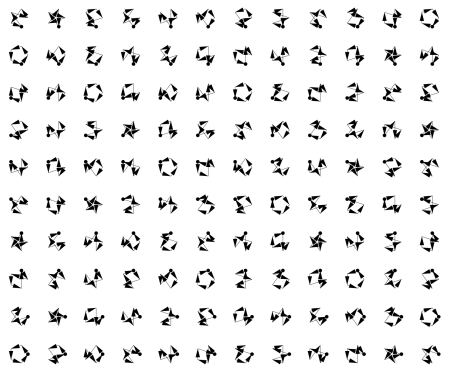
For no particular reason at all a figure showing all possible 120 permutations of 5 points: permutationsof5.pdf